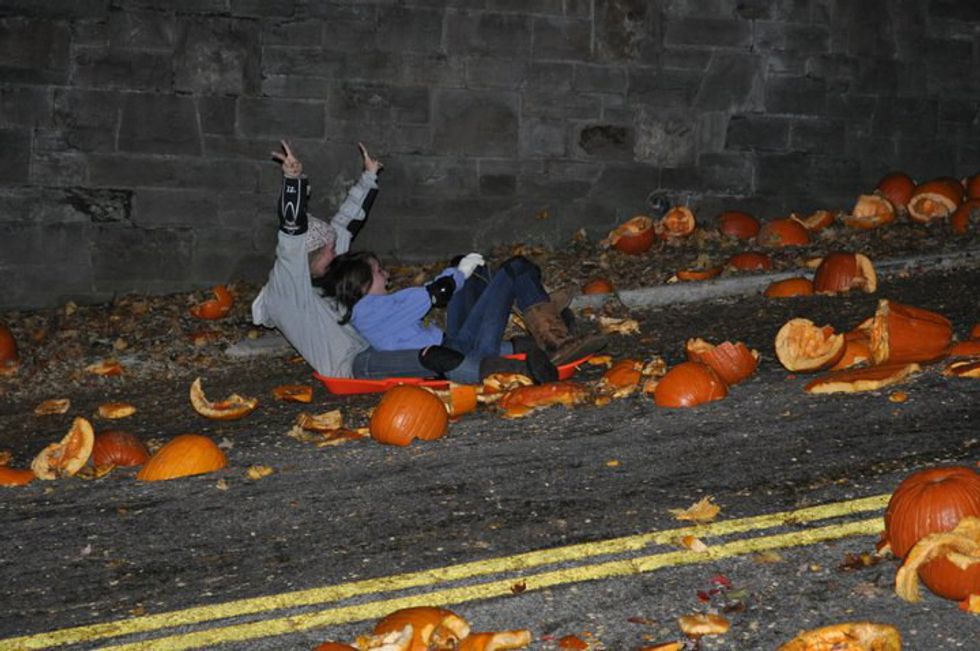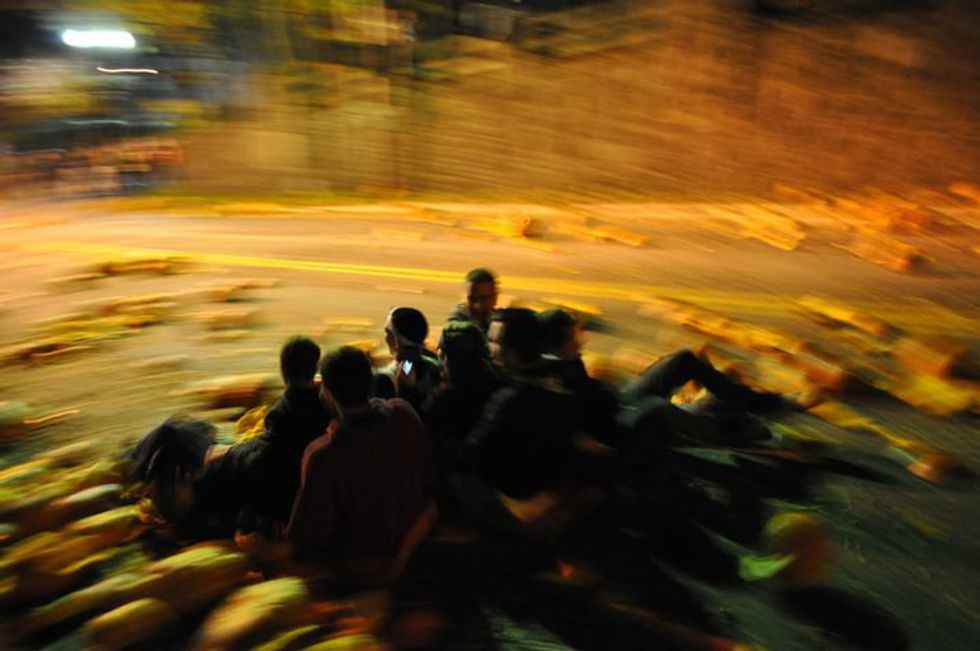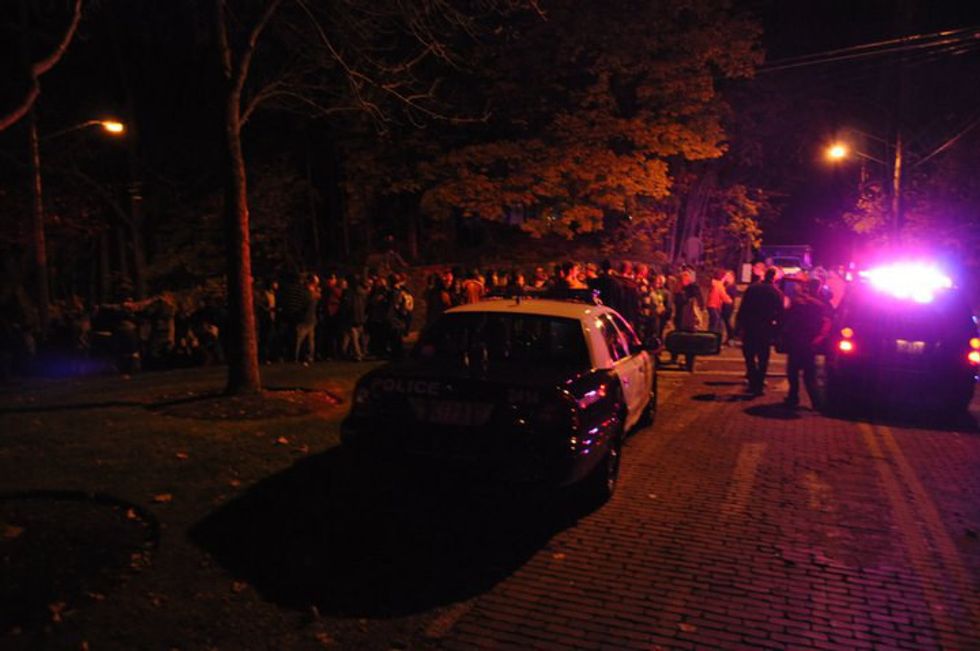Speaking as someone who has lived here for 23 years, Chagrin Falls, Ohio is not an exceedingly exciting place to live. It’s certainly a pleasant environment, quaint and innocuous with sidewalk sales and farmers markets, and the Blossom Time Festival on Memorial Day. However, like almost any small American town, we have one tradition which is unique to our community, opinions of which are highly contentious: the infamous Pumpkin Roll. Depending on whom you speak to in Chagrin Falls, the Pumpkin Roll is either a storied tradition, part of the town’s history and one of the most meaningful parts of our high school upperclassmen’s experience, or a tacit admission, even encouragement, of lawless behavior which is protected by misguided reverence. With this year’s Pumpkin Roll imminent, I thought I’d take this opportunity to share with everyone who isn’t aware of our annual gourd genocide the history of the event, as well as what can be expected to happen that night, common criticisms of the event, and why it has persisted for almost five decades.
For those readers who are unaware of what the Pumpkin Roll actually is, the name is actually a very concise description: one night a year at midnight, almost always in the last week of October barring inclement weather, the Junior and Senior classes of Chagrin Falls High School gather at the top of Grove Hill, the very steep incline of Main Street which intersects Summit Street at its apex. From this elevated position hundreds of pumpkins are thrown, smashed to bits on the asphalt until the entire incline is slick with goop and pumpkin seeds a scattered like confetti on D-Day. Then the assembled students take it in turns to throw themselves after the pumpkins on sleds, recycling bins and even bits of cardboard or plywood. It’s a great deal of fun, if not more than a little hazardous to one’s health. Though it may seem just from that brief synopsis to be harmless, not counting scrapes and bruises, there are legitimate concerns which arise from the observation of our (admittedly) bizarre tradition.
The first Pumpkin Roll was an inauspicious affair, in stark contrast to the widely known and police chaperoned affair it has become in the 47 years since its inception. In 1969, a handful of students backed a single flatbed truck loaded with 69 pumpkins to the top of Grove Hill, dumped them, and ran. The prank, orchestrated by two brothers, Steve and Allen Leach, became a tradition when Steve and Allen’s younger brother and his classmates repeated the act two years later. In 1976, seven years after the first Pumpkin Roll, students dumped nine hundred pumpkins. There are records for both the largest number of pumpkins thrown down the hill in a single year, approximately two thousand by the class of 2007, and for the largest pumpkin, weighing in at a whopping 775 pounds.
Of course, the method by which the hundreds of pumpkins are gathered is one of the most controversial aspects of the affair: although some are donated or purchased, the majority are stolen in the weeks before the roll from area residences, farms and businesses, which is one source of the ire which the Roll can inspire in residents who are opposed to the tradition. The practice is so systemic and has persisted for so long that the populace of Chagrin Falls has largely adapted to the occurrence: many people take their pumpkins inside at night, or in a few extreme cases invest in thief deterrents such as barbed wire. This has given rise to another problem, since students are now traveling further from home in search of unattended pumpkins, victimizing adjacent towns which aren’t as familiar with the custom, or as forgiving when they wake up the next morning to find they have become unwilling donors to the Pumpkin Roll. Every year a handful of students are caught stealing and charged with misdemeanor petty theft and issued a fine, though the cost for such an infraction can be higher than just the financial cost: many of these students are on their way to college in a year or less, and a legal blemish on their record can have serious repercussions for their prospects.
For their part, the police tolerate the event without condoning it, realizing there’s no practical way to stop such a large gathering, opting instead to oversee the proceedings and step in if anything gets extraordinarily out of hand. They set up barricades to halt the normal flow of traffic, and they inevitably intervene and end the event once too many students are found to be intoxicated or a severe injury is sustained. The setting up barricades at the top and bottom of the hill to block traffic and monitoring the event itself; every year a handful of students are arrested for underage drinking, and the students who drove the truckloads of pumpkins to the assigned spot are issued a ticket for illegal dumping. A collection among the student body is later used to pay this fine. Injuries are a guarantee, from minor scrapes and bruises to more serious injuries like broken bones that require hospitalization. In 2008 a Solon man was an onlooker at the event when a sled hit him on the sidewalk; he fractured his skull and was taken to Hillcrest Hospital in critical condition, according to Cleveland.com.
As for a greater reasoning or justification behind why the tradition continues, as with so many traditions there honestly isn’t much of a reason why the Pumpkin Roll persists beyond the maintaining of the tradition itself. For my part, I attended both of my allotted years, though on neither occasion did I have anything to drink, and while I did enjoy myself I could understand even then why so many call for an end to the tradition: at best dozens of people throwing themselves down a concrete slope on sleds is not very smart, to put it mildly, and at worst it’s a tacit invitation for young adults to break the law, to steal and drink and leave a mess behind that can be seen for weeks afterward, even after the city has done its best to clean up the detritus left behind in the Pumpkin Roll’s wake. Calls to end the Pumpkin Roll are always short-lived, since a large number of the events past participants stay in Chagrin Falls, growing into nostalgic adults with children of their own who participate when it comes their time to do so. The best we can likely hope to accomplish is to teach those involved responsible behavior, especially with regard to alcohol consumption. If anyone ever dies during the Roll, we’ll likely see it come under greater scrutiny and the calls to end the yearly event intensify, but until then the Roll will persist, disdained by some and beloved by others.



























